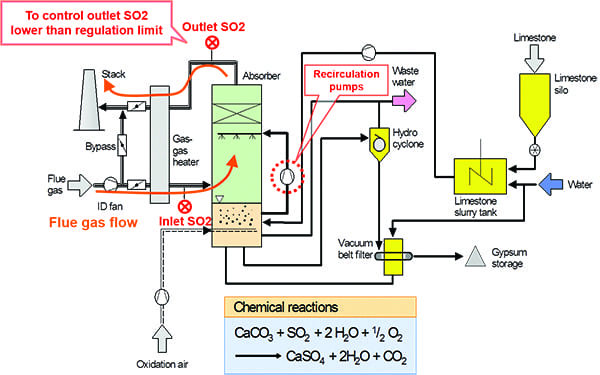Flue Gas Desulphurisation
The Union Environment Ministry is reconsidering its 2015 mandate for Flue Gas Desulphurisation (FGD) in all coal-fired plants. A recent study by the National Institute of Advanced Studies suggests that FGD should only be required for plants using imported or high sulphur coal. This change is driven by the composition of coal used in India and its impact on air quality.
About Flue Gas Desulphurisation (FGD)
FGD is a technology aimed at removing sulphur dioxide (SO2) from exhaust emissions. SO2 primarily originates from burning fossil fuels like coal and oil. When these fuels are combusted, portion of their sulphur content is converted to SO2, a harmful air pollutant. FGD processes can remove up to 95% of SO2 using absorbents like ammonia, sodium sulphite, or limestone slurry.
Sources and Impacts of Sulphur Dioxide
Sulphur dioxide is a major contributor to air pollution. It can lead to acid rain, which adversely affects forests, freshwater bodies, and soil health. The consequences include damage to ecosystems, corrosion of infrastructure, and deterioration of cultural heritage sites. Therefore, reducing SO2 emissions is crucial for environmental protection.
Current Status of FGD Implementation
Despite a deadline for FGD installation in 2018, only 8% of India’s coal-fired power plants have complied. Compliance deadlines have been extended to 2027-2029. Approximately 230 plants are working on FGD installation, while 260 have yet to place orders. The cost of FGD installation is estimated at ₹1.2 crore per megawatt.
Analysis of Coal Quality and Emissions
The majority of coal used in Indian plants has low sulphur content (0.3%-0.5%). The Central Pollution Control Board’s regulations on stack heights and India’s climatic conditions have mitigated SO2 emissions’ impact on local air quality. A 2024 study by IIT-Delhi found that acid rain was not issue in India.
Environmental Trade-offs
Installing FGD across all plants could lead to increased power and freshwater consumption. It may also result in an additional 69 million tonnes of CO2 emissions from 2025 to 2030, while only reducing SO2 emissions by 17 million tonnes. This raises concerns about exacerbating global warming.
Alternative Solutions for Air Pollution
The NIAS study recommends focusing on reducing particulate matter (PM) pollution instead of solely targeting SO2 emissions. Installing electrostatic precipitators could reduce PM pollution at a fraction of the cost of FGD. This approach is projected to have a more substantial impact on air quality.
Policy Recommendations
The study argues for a rollback of the FGD mandate, stating that it was a misstep. The evidence suggests that addressing PM emissions would be more beneficial for air quality. The Environment Ministry is urged to reconsider its policy based on these findings.
Month: Current Affairs - April, 2025
Category: Environment Current Affairs








